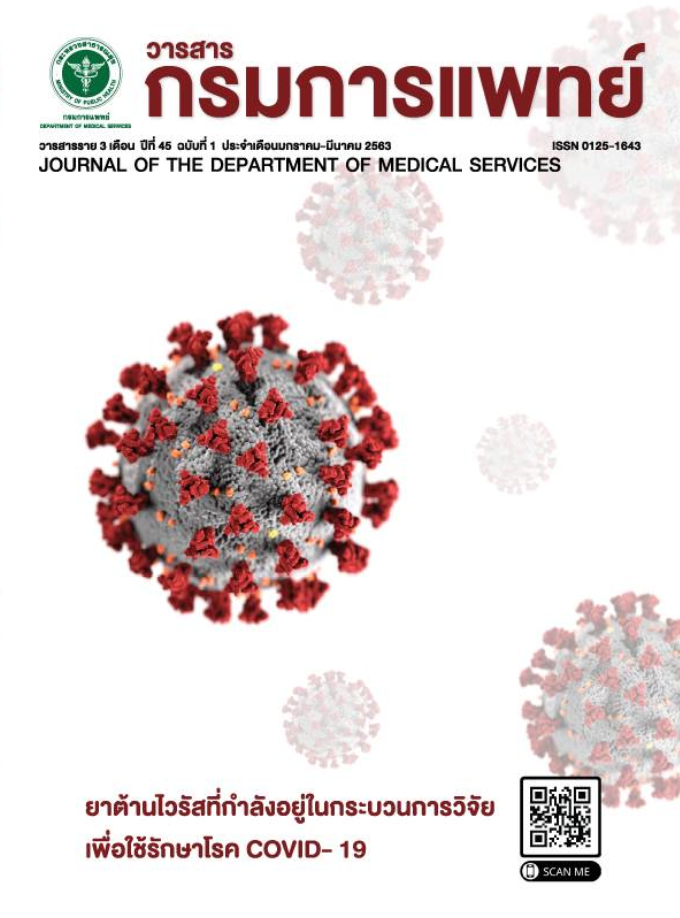ผลทางคลินิกของผู้ป่วยโรคหัวใจเต้นระริกที่มีโรคลิ้นหัวใจ ชนิดที่ไม่ได้เกิดจากโรคหัวใจรูมาติกในประเทศไทย
คำสำคัญ:
โรคลิ้นหัวใจชนิดทีไม่ได้เกิดจากโรคหัวใจรูมาติก, โรคหัวใจเต้นระริก, โรคหัวใจเต้นระริกชนิดที่ไม่มีโรคลิ้นหัวใจ, ยาละลายลิ่มเลือด, โรคหลอดเลือดสมอง, เลือดออกผิดปกติบทคัดย่อ
ภูมิหลัง : โรคหัวใจเต้นระริกชนิดที่ไม่มีโรคลิ้นหัวใจ เป็นสาเหตุสำคัญของโรคหัวใจเต้นระริกในเวชปฏิบัติ การศึกษา ส่วนใหญ่แสดงว่าการให้ยาละลายลิ่มเลือดช่วยลดความเสี่ยงในการเกิดโรคที่เกิดจากลิ่มเลือดอุดตัน แต่จนถึงปัจจุบันยังไม่มี การศึกษาผลทางคลินิกตลอดจนการให้ยาละลายลิ่มเลือดในผู้ป่วยที่มีโรคลิ้นหัวใจชนิดที่ไม่ได้เกิดจากโรคลิ้นหัวใจรูมาติก และโรคหัวใจเต้นระริก
วัตถุประสงค์ : เพื่อศึกษาผลทางคลินิกของผู้ป่วยโรคหัวใจเต้นระริกที่มีโรคลิ้นหัวใจชนิดที่ไม่เกิดจาก โรคลิ้นหัวใจรูมาติกเปรียบเทียบกับผู้ป่วยโรคหัวใจเต้นระริกชนิดที่ไม่มีโรคลิ้นหัวใจ
วิธีการ : การศึกษานี้เป็นการศึกษา แบบย้อนหลังในผู้ป่วยโรคหัวใจเต้นระริกในสถาบันโรคทรวงอกระหว่างเดือนมกราคม พ.ศ.2558 ถึงเดือนมกราคม พ.ศ. 2560 โดยได้แบ่งผู้ป่วยเป็นผู้ป่วยโรคหัวใจเต้นระริกที่ไม่มีโรคลิ้นหัวใจชนิดที่ไม่ได้เกิดจากโรคลิ้นหัวใจรูมาติกและผู้ป่วยโรค หัวใจเต้นระริกชนิดที่ไม่มีโรคลิ้นหัวใจ ผลลัพธ์หลักคือการเกิดโรคสมองขาดเลือดและผลลัพธ์รองคือ การเกิดเลือดออกใน สมอง การเกิดเลือดออกในทางเดินอาหาร หรือการเสียชีวิตจากทุกสาเหตุ โดยผลลัพธ์หลักและผลลัพธ์รองจะได้รับวิเคราะห์ ด้วย chi-square test
ผล : ผู้ป่วยโรคหัวใจเต้นระริก 146 รายได้เข้าสู่การศึกษา มีผู้ป่วยโรคหัวใจเต้นระริกที่มีโรคลิ้นหัวใจ ที่ไม่เกิดจากโรคลิ้นหัวใจรูมาติก 40 ราย และผู้ป่วยโรคหัวใจเต้นระริกที่ไม่มีโรคลิ้นหัวใจ 106 ราย พบโรคสมองขาดเลือดใน ผู้ป่วยโรคหัวใจเต้นระริกที่มีโรคลิ้นหัวใจที่ไม่เกิดจากโรคลิ้นหัวใจรูมาติก 3 ราย (7.50%) และในผู้ป่วยโรคหัวใจเต้นระริกที่ ไม่มีโรคลิ้นหัวใจ 10 ราย (9.40%) [RR 0.79; 95 CI, 0.23 to 2.74; p = 0.71] ไม่พบเลือดออกในสมองในผู้ป่วยโรคหัวใจ เต้นระริกที่มีโรคลิ้นหัวใจที่ไม่เกิดจากโรคลิ้นหัวใจรูมาติก (0%) และมีเลือดออกในสมองในผู้ป่วยโรคหัวใจเต้นระริกที่ไม่มี โรคลิ้นหัวใจ 4 ราย (3.77%) [RR 0; p = 0.21] มีเลือดออกในทางเดินอาหาร 4 รายในผู้ป่วยโรคหัวใจเต้นระริกที่มีโรค ลิ้นหัวใจที่ไม่เกิดจากโรคลิ้นหัวใจรูมาติก (10%) และ 2 รายในผู้ป่วยโรคหัวใจเต้นระริกที่ไม่มีโรคลิ้นหัวใจ (1.89%) [RR 5.3; 95% CI, 1.00 to 27.81; p = 0.02] มีผู้ป่วยเสียชีวิต 8 รายในผู้ป่วยโรคหัวใจเต้นระริกที่มีโรคลิ้นหัวใจที่ไม่เกิดจากโรค ลิ้นหัวใจรูมาติก (20%) และ 4 รายในผู้ป่วยโรคหัวใจเต้นระริกที่ไม่มีโรคลิ้นหัวใจ (3.77%) [RR 5.43; 95% CI, 1.73 to 17.04; p < 0.01]
สรุป : ผู้ป่วยโรคหัวใจเต้นระริกที่มีโรคลิ้นหัวใจที่ไม่เกิดจากโรคลิ้นหัวใจรูมาติกมีเลือดออกในทางเดินอาหารและ เสียชีวิตมากกว่าผู้ป่วยโรคหัวใจเต้นระริกที่ไม่มีโรคลิ้นหัวใจ ยาละลายลิ่มเลือดสามารถป้องกันโรคสมองขาดเลือดได้ไม่แตกต่าง กันในผู้ป่วยทั้งสองกลุ่ม อย่างไรก็ตาม ความเสี่ยงที่เพิ่มขึ้นของการเกิดเลือดออกทางเดินอาหารและเสียชีวิตจะจำกัดในการใช้ ยาละลายลิ่มเลือดในผู้ป่วยกลุ่มนี้
เอกสารอ้างอิง
Cooper NJ, Sutton AJ, Lu G, Khunti K. Mixed comparison of stroke prevention treatments in individuals with nonrheumatic atrial fibrillation. Arch Intern Med 2006; 166:1269-75.
Friberg L, Rosenqvist M, Lip GY. Net clinical benefit of warfarin in patients with atrial fibrillation: a report from the Swedish atrial fibrillation cohort study. Circulation 2012; 125:2298-307.
Kirchhof P, Benussi S, Kotecha D, Ahlsson A, Atar D, Casadei B, et al. 2016 ESC Guidelines for the management of atrial fibrillation developed in collaboration with EACTS. Eur Heart J 2016; 37:2893-962.
Molteni M, Polo Friz H, Primitz L, Marano G, Boracchi P, Cimminiello C. The definition of valvular and non-valvular atrial fibrillation: results of a physicians’ survey. Europace 2014; 16:1720–5.
Kernan WN, Ovbiagele B, Black HR, Bravata DM, Chimowitz MI, Ezekowitz MD, et al. Guidelines for the prevention of stroke in patients with stroke and transient ischemic attack: a guideline for healthcare professionals from the American Heart Association/American Stroke Association. Stroke 2014; 45:2160-236.
Sinser DE, Hughes RA, Gress DR, Sheehan MA, Oertel LB, Maraventano SW, et al. The effect of low-dose warfarin on the risk of stroke in patients with non-rheumatic atrial fibrillation, N Engl J Med 1990; 323: 1505-11.
Ezekowitz MD, Bridgers SL, James KE, Carliner NH, Colling CL, Gornick CC et al. Warfarin in the prevention of stroke associated with nonrheumatic atrial fibrillation. Veterans Affairs Stroke Prevention in Nonrheumatic Atrial Fibrillation Investigators. N Engl J Med 1992; 327: 1406-12.
Philippart R, Brunet-Bernard A, Clementy N, Bourguignon T, Mirza A, Babuty D, et al. Prognostic value of CHA2DS2-VASc score in patients with ‘non-valvular atrial fibrillation’ and valvular heart disease: the Loire Valley Atrial Fibrillation Project. Eur Heart J 2015; 36: 1822–30.
Di Biase L. Use of Direct Oral Anticoagulants in Patients with Atrial Fibrillation and Valvular Heart Lesions. J Am Heart Assoc 2016; 5:e002776.
Breithardt G, Baumgartner H, Berkowitz SD, Hellkamp AS, Piccini JP, Stevens SR, et al. Clinical characteristics and outcomes with rivaroxaban vs. warfarin in patients with non-valvular atrial fibrillation but underlying native mitral and aortic valve disease participating in the ROCKET AF trial. Eur Heart J 2014; 35:3377-85.
Avezum A, Lopes RD, Schulte PJ, Lanas F, Gersh BJ, Hanna M, et al. Apixaban in Comparison With Warfarin in Patients With Atrial Fibrillation and Valvular Heart Disease. Findings From the Apixaban for Reduetion in Stroke and Other Thromboembolic Events in Atrial Fibrillation (APISTOTLE) Trial. Circulation 2015; 132:624-32.
Ezekowitz MD, Nagarakanti R, Noack H, Brueckmann M, Litherland C, Jacobs M, et al. Comparison of Dabigatran and Warfarin in Patients with Atrial Fibrillation and Valvular Heart Disease: The RE-LY Trial (Randomized Evaluation of Long–Term Anticoagulant Therapy). Circulation 2016; 134:589-98.
De Caterina R, Renda G, Carnicelli AP, Nordio F, Trevisan M, Mercuri MF, et al. Valvular Heart Disease Patients on Edoxaban or Warfarin in the ENGAGE AF-TIMI 48 Trial. J Am Coll Cardiol 2017; 69:1372-82.
ดาวน์โหลด
เผยแพร่แล้ว
รูปแบบการอ้างอิง
ฉบับ
ประเภทบทความ
สัญญาอนุญาต
บทความที่ได้รับการตีพิมพ์เป็นลิขสิทธิ์ของกรมการแพทย์ กระทรวงสาธารณสุข
ข้อความและข้อคิดเห็นต่างๆ เป็นของผู้เขียนบทความ ไม่ใช่ความเห็นของกองบรรณาธิการหรือของวารสารกรมการแพทย์



